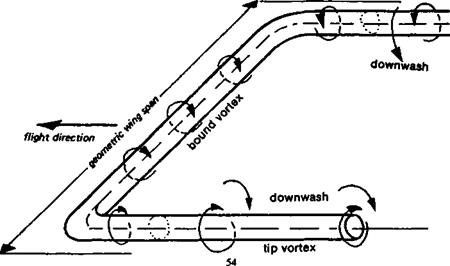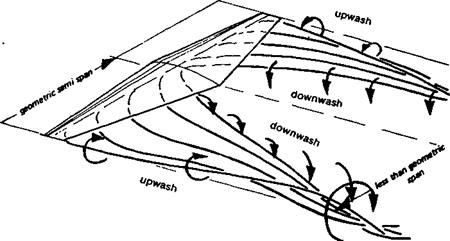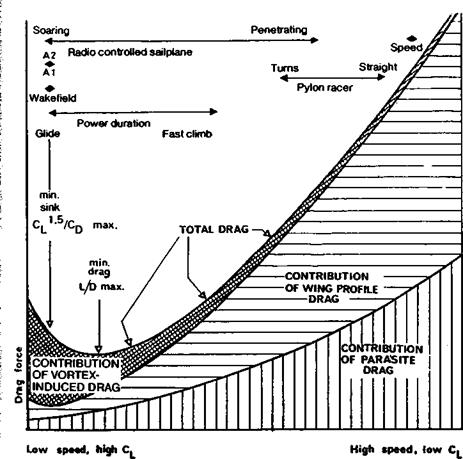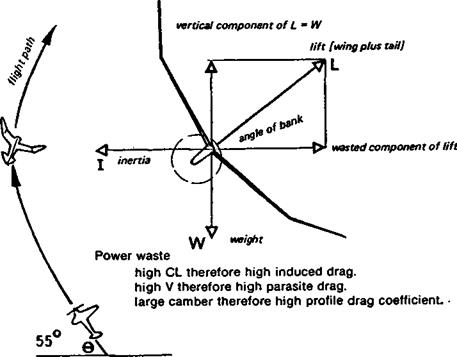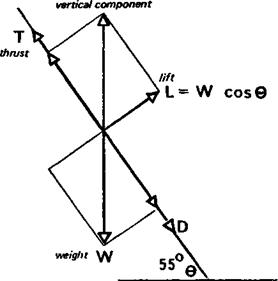THE REYNOLDS NUMBER LIMIT
There is an aerodynamic limit to the benefits of high aspect ratio, connected with scale effects as mentioned in Chapter 3, and further discussed in Chapter 7. It may be expected that if the increase of a. r. with a wing of given area results in too small a wing chord, the Reynolds number of the wing will be too low for efficient flight This can usually be prevented by careful attention to choice of aerofoil sections of such a wing. To anticipate Chapter 7, thin aerofoils are required for low Re wings, and at tips on tapered wings.
5.5 ASPECT RATIO AND TRIM SENSITIVITY
It follows directly from the effects of downwash on the angle of attack that high aspect ratio wings are inherently sensitive to changes of trim and to up and down gusts in flight The effect is compounded by what has just been said about the choice of aerofoils for operations at low Re. The thin type of profile needed for low Re turns out to be especially sensitive to slight changes of angle of attack because of the behaviour of the separation bubbles which form on the upper surfaces of such aerofoils. Quite apart from this if the variation of Cl with angle of attack is plotted on a graph for wings of various aspect ratios, as shown in Figure 5.8, it is found that the slope of the lift curve for the high aspect ratio wing is greater than that of the low a. r. surface. This follows from what has been said before; to achieve the same Cl with a low a. r. and large downwash, the geometric angle of attack must be higher. The aspect ratio has no effect on the angle at which the wing reaches Cl zero; this depends almost entirely on the wing camber. On the other hand, the maximum Cl of the high and moderate a. r. wings is the same since the occurrence of the stall depends on details of the boundary layer flow as described in Chapter 3. The high a. r. wing reaches this maximum Cl at a lower stalling angle, and as the diagram shows, the usable range of angles of attack is smaller.
A wing of infinite aspect ratio would have the greatest possible lift curve slope, as suggested by the broken line in Figure 5.8. The actual slope would depend on the aerofoil, but it can be shown that many aerofoils at high Re values, increase Ci by about. 11 for each degree increase of angle or attack, at angles below stalling. Thin aerofoils at low Re, however, have unusually steep lift curve slopes, more than 0.11 per degree, which makes the high aspect ratio models using them even more sensitive in pitch. A gust in flight may easily change the angle of attack of a slow flying model by several degrees, and if the lift curve slope is steep such a change may take the wing up to the stall or down close to zero lift
Apart from gust effects, radio controlled models with high aspect ratio, like full-sized sailplanes, are highly sensitive to elevator control. A small elevator movement can change the angle of attack of the main wing enough to cause a dramatic and sudden change of the lift forces: the lift momentarily exceeds the weight by a large margin. Violent acceleration
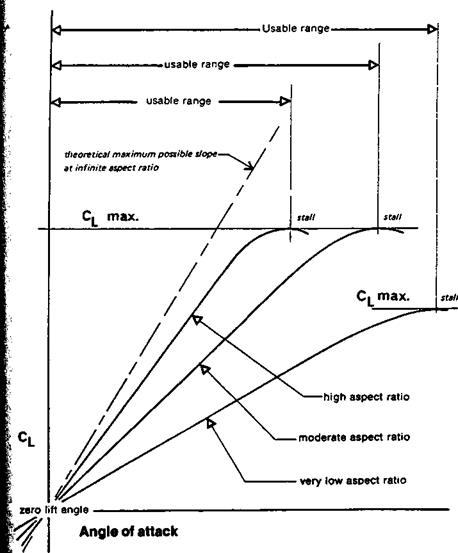
 The slope of the lift curve at different aspect ratios
The slope of the lift curve at different aspect ratios
results, and the inertia, or *g of the fuselage and all the concentrated items of mass in the model, oppose this. The wings deflect like archery bows and if insufficiently strong, may break. Such large deflections may also have unpredictable side effects, changing the stability and balance of the model, causing control rods in wings to bind or jam, wrinkling the covering or initiating wing flutter.
In trimming high a. r. models, small slivers of packing under the tailplane or wing have relatively large effects on the rigging angles of the narrow chord surfaces. On radio controlled models, for the same reason, sloppy control hinges, badly fitting push-rod ends, inaccurately centring servos, control rods that bend under load or expand in hot weather, all cause more trouble than they do on low a. r. models.













 Fig. 5.7 Aspect ratio
Fig. 5.7 Aspect ratio I,
I,
